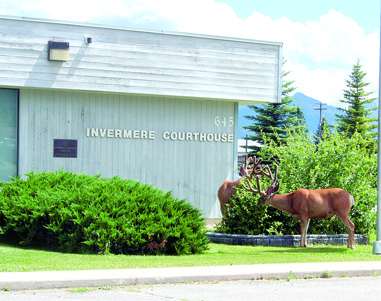District of Invermere council gave unanimous blessing to a plan to relocate and cull deer living within district limits, but the extent and swiftness of the program will likely depend on the B.C. government’s response to the proposal.
The recommendations, passed at a special council meeting August 3, are courtesy of the district’s Urban Deer Committee, struck in response to the area’s rising, human-habituated deer population.
Its suggestion: relocate some deer to the Upper Kootenay River Valley, and dispatch others using traps and bolt guns. Unlike tranquilized deer, those shot with bolt guns can be used for meat after they are culled (the district hopes to give some deer meat to the food bank).
The report also urges the district to educate residents on non-lethal options to “discourage deer or reduce incidents,” which could include planting deer-resistant plants and putting up fences. A cull could begin this fall, while relocation is slated for the spring.
While she voted in favour of the plan, councillor Spring Hawes said she was struggling with the issue on a personal level.
“I think the report is totally realistic and practical and I support the report,” she said. “But I still have a huge personal issue with killing deer. I’m not a hunter, that’s not where I come from at all. So I guess I just want to make clear my own personal reservations.”
Hawes said she’d like to see the district minimize the number of deer it needs to put down, and carry out its plan in the “most humane and most reasonable way we possibly can.”
“It’s a lose-lose issue,” added mayor Gerry Taft. “No matter what you do, you’re going to annoy some people.”
However, many at the council table thought opposition to the plan might not be as strong as it was in the past, due to increasing reports of deer aggression both in the district and other nearby communities.
Over the last several years deer attacks in Cranbrook and Kimberley have made national headlines, and both cities are already talking with the province about population control.
“The passions seem to have died down. I think people — the people I’ve talked to anyway — have started to agree something has to be done,” said councillor Bob Campsall.
“Two years ago you mentioned deer aggression and people laughed. It was a joke,” added Taft. “All of a sudden, I think people are taking that a little more seriously. It’s not quite as funny as it used to be and it’s a little more real.”
While Invermere won’t be the first community to approach the province about deer control, council isn’t sure how the B.C. government will respond when it’s asked to help run and pay for the program. The district is also asking the government to loosen its restrictions on what can be done with the deer after the cull. Currently the meat can only go to food banks or First Nations groups, who aren’t expected to need as much venison as will be on offer.
“Potentially both of those are long shots,” Taft said of the district’s requests, adding he expects the program will be fine-tuned depending on the answers the community receives.
“I do think it will come back to council, especially for budget considerations. And this big question is what role does the province play?” he added. “That’s a big, looming question. We’re not really sure.”
Too expensive?
A former Columbia Valley conservation officer is calling the district’s deer-control program a waste of public funds.
Leslie “Buzz” Harmsworth told council he thinks relocating the animals is too expensive and logistically difficult to be part of the community’s solution.
“I just can’t see my taxpayer dollars being spent on some kind of emotional thing,” he said. “If you don’t like deer, fence them out. I think this movement of the deer is a gross waste of the public purse.”
Harmsworth says he would, however, be in favour of the other part of the deer-management plan: a cull.
